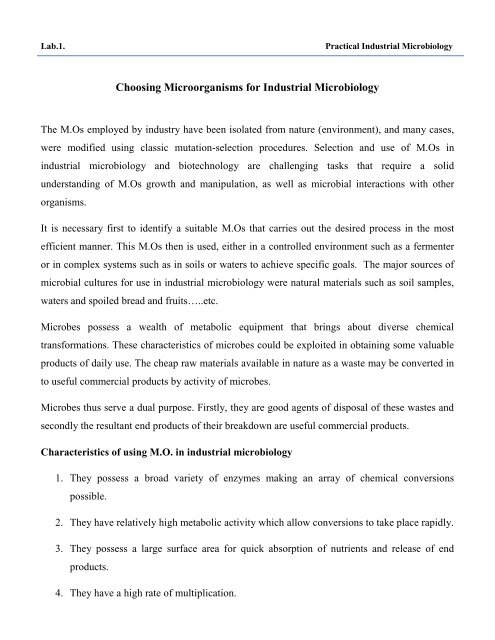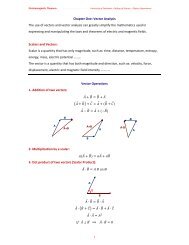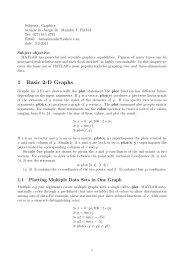Choosing Microorganisms for Industrial Microbiology
Choosing Microorganisms for Industrial Microbiology
Choosing Microorganisms for Industrial Microbiology
You also want an ePaper? Increase the reach of your titles
YUMPU automatically turns print PDFs into web optimized ePapers that Google loves.
Lab.1.<br />
Practical <strong>Industrial</strong> <strong>Microbiology</strong><br />
<strong>Choosing</strong> <strong>Microorganisms</strong> <strong>for</strong> <strong>Industrial</strong> <strong>Microbiology</strong><br />
The M.Os employed by industry have been isolated from nature (environment), and many cases,<br />
were modified using classic mutation-selection procedures. Selection and use of M.Os in<br />
industrial microbiology and biotechnology are challenging tasks that require a solid<br />
understanding of M.Os growth and manipulation, as well as microbial interactions with other<br />
organisms.<br />
It is necessary first to identify a suitable M.Os that carries out the desired process in the most<br />
efficient manner. This M.Os then is used, either in a controlled environment such as a fermenter<br />
or in complex systems such as in soils or waters to achieve specific goals. The major sources of<br />
microbial cultures <strong>for</strong> use in industrial microbiology were natural materials such as soil samples,<br />
waters and spoiled bread and fruits…..etc.<br />
Microbes possess a wealth of metabolic equipment that brings about diverse chemical<br />
trans<strong>for</strong>mations. These characteristics of microbes could be exploited in obtaining some valuable<br />
products of daily use. The cheap raw materials available in nature as a waste may be converted in<br />
to useful commercial products by activity of microbes.<br />
Microbes thus serve a dual purpose. Firstly, they are good agents of disposal of these wastes and<br />
secondly the resultant end products of their breakdown are useful commercial products.<br />
Characteristics of using M.O. in industrial microbiology<br />
1. They possess a broad variety of enzymes making an array of chemical conversions<br />
possible.<br />
2. They have relatively high metabolic activity which allow conversions to take place rapidly.<br />
3. They possess a large surface area <strong>for</strong> quick absorption of nutrients and release of end<br />
products.<br />
4. They have a high rate of multiplication.
5. They should be easily cultivated and maintained.<br />
6. They should have genetic stability with infrequent mutation.<br />
Medium and conditions <strong>for</strong> microbial growth<br />
After selecting the suitable microbes <strong>for</strong> the purpose, it is necessary to develop a fermentation<br />
process that optimizes conditions <strong>for</strong> desired microbial activity and that should yield maximum<br />
amount of the product with highest economic profit. The organic and inorganic composition of<br />
the medium, pH, temperature and O2 concentration are the main factors that are varied to<br />
maximize the efficiency of production process. Essential nutrients in the medium <strong>for</strong> microbial<br />
growth include C, N, P and growth factors and the choice can be made on economic and<br />
biological grounds.<br />
Nutrient<br />
Raw material (sources)<br />
Carbon & energy Molasses, whey, corn sugar, starch, cellulose, vegetable oil, agricultural<br />
source<br />
wastes (corn cobs), petroleum fractions.<br />
Nitrogen sources Soybean meal, corn-steep liquor (from corn milling), stick liquor (slaughter<br />
house products), nitrate salts, pure ammonia or ammonium salts, air (<strong>for</strong> N2<br />
fixers).<br />
Phosphorus Phosphate salts<br />
source<br />
Vitamin Crude preparations of plant and animal products.<br />
Iron, trace salts<br />
Crude inorganic chemicals.

















